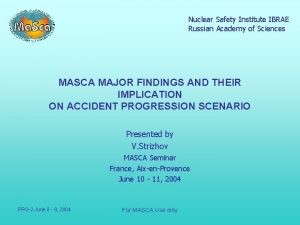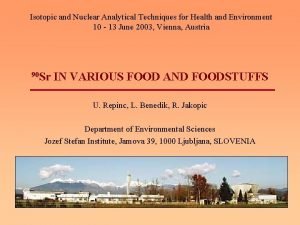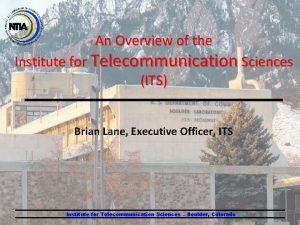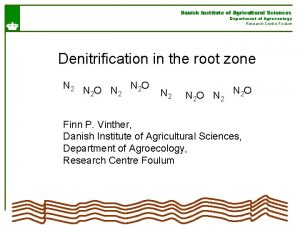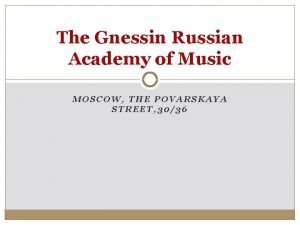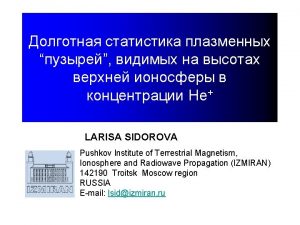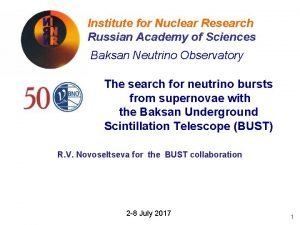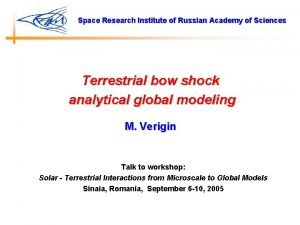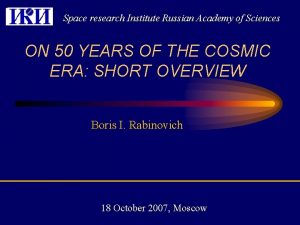RUSSIAN ACADEMY OF SCIENCES PUSHKOV INSTITUTE OF TERRESTRIAL



![Relation to the solar wind velocity [Krymskiy, 1964] Relation to the solar wind velocity [Krymskiy, 1964]](https://slidetodoc.com/presentation_image_h2/4780ac74ccbc3eba70e2fc004ac2f0a0/image-4.jpg)








- Slides: 12

RUSSIAN ACADEMY OF SCIENCES PUSHKOV INSTITUTE OF TERRESTRIAL MAGNETISM, IONOSPHERE AND RADIO WAVE PROPAGATION (IZMIRAN) COSMIC RAY ANISOTROPY IN THE DIFFERENT SITUATIONS OF THE SOLAR WIND Abunina M. A. , Belov A. V. , Abunin A. A. , Eroshenko E. A. , Oleneva V. A. , Yanke V. G.

COSMIC RAY ANISOTROPY Equatorial coordinate system Cosmic ray anisotropy – inhomogeneity of the angular distribution of the galactic cosmic ray intensity direction of the Axy vector – phase magnitude of the Axy vector – amplitude particle rigidity – 10 GV

Main features of the equatorial component of the cosmic ray vector anisotropy Data from 1957 to 2013 In total > 492 thousands of hours v changes from 0 to >10% v average size of Axy = 0. 60%, median size of Axy = 0. 53% v average size of Axy = 0. 539± 0. 004% – at negative polarity of a solar dipole average size of Axy = 0. 505± 0. 004% – at positive polarity
![Relation to the solar wind velocity Krymskiy 1964 Relation to the solar wind velocity [Krymskiy, 1964]](https://slidetodoc.com/presentation_image_h2/4780ac74ccbc3eba70e2fc004ac2f0a0/image-4.jpg)
Relation to the solar wind velocity [Krymskiy, 1964]

Relation to the solar wind velocity V ≥ 700 km/s cc = 0. 37

Relation to the solar wind velocity

Relation to the IMF intensity cc = 0. 26

Relation to the IMF intensity

Relation to the CR density , A 0 – CR density variations

Average characteristics of the CR anisotropy in the different situations of the solar wind № Interplanetary medium parameters 1 2 3 4 5 6 7 8 9 10 11 12 V = 335 -385 km/s, B = 2. 5 -5. 5 n. T V < 335 km/s, B = 2. 5 -5. 5 n. T V ≥ 450 km/s, B = 2. 5 -5. 5 n. T d. V ≥ 10 km/s, B ≥ 7 n. T d. V ≤ – 10 km/s, B ≤ 5 n. T d. V ≤ – 10 km/s, B ≥ 7 n. T V ≤ 400 km/s, B ≥ 8 n. T V ≤ 300 km/s, B ≤ 3 n. T V ≥ 500 km/s, B ≥ 10 n. T d. A 0* < – 0. 2 %, B ≥ 7 n. T d. A 0 > 0. 2 %, B ≤ 6 n. T *d. A 0 – CR density variations during one hour Number of hours 19401 15189 10503 27820 28961 19530 21581 2796 8872 5085 2472 760 Ax, % Ay, % Axy, % 0. 02± 0. 01± 0. 01 0. 05± 0. 01 0. 08± 0. 01 0. 04± 0. 01 0. 12± 0. 01 0. 10± 0. 01 0. 06± 0. 01 0. 18± 0. 01 0. 19± 0. 02 0. 05± 0. 03 0. 36± 0. 01 0. 35± 0. 01 0. 37± 0. 01 0. 48± 0. 01 0. 37± 0. 01 0. 46± 0. 01 0. 44± 0. 01 0. 34± 0. 01 0. 56± 0. 01 0. 76± 0. 02 0. 54± 0. 03 0. 52± 0. 04 0. 53± 0. 01 0. 51± 0. 01 0. 70± 0. 01 0. 54± 0. 01 0. 76± 0. 01 0. 68± 0. 01 0. 51± 0. 01 0. 97± 0. 01 1. 22± 0. 02 1. 02± 0. 03 0. 89± 0. 04

What can the CR anisotropy tell about? Q-wind: B<7 n. T, V<500 km/s D-wind: B>10 n. T, V>600 km/s E-wind: B>15 n. T, V>600 km/s Q-wind (54. 94%) D-wind (1. 09%) E-wind (0. 38%) Axy = 0. 4 -0. 6% abs(d. A 0) < 0. 05% 56. 92% 61. 3% 0. 58% 0. 34% 0. 13% 0. 037% Axy > 2% d. A 0 < -0. 5% 21. 69% 6. 91% 13. 56% 28. 26% 8. 32% 18. 89%

Main conclusions • Using a large experimental material on hourly data from NMs we revealed the main futures of the CR anisotropy (with rigidity 10 GV). • We studied the relation of the equatorial component of vector CR anisotropy with interplanetary characteristics. • Any measured or easily calculated parameter of the interplanetary environment doesn't show close correlation with the size of CR vector anisotropy. However an increase of vector anisotropy follows to a combinations of the parameters of the environment manifested its disturbances. Most obviously increase of anisotropy is promoted by considerable changes of CR density and speed of a solar wind, and also strengthening of the IMF. • Knowing the value of CR anisotropy can judge about the disturbances of the interplanetary medium.
 Nuclear safety institute of the russian academy of sciences
Nuclear safety institute of the russian academy of sciences Human science tok
Human science tok Health and environmental sciences institute
Health and environmental sciences institute Institute for telecommunication sciences
Institute for telecommunication sciences Symbiosis hospital management
Symbiosis hospital management Kafue institute of health sciences
Kafue institute of health sciences Danish institute of agricultural sciences
Danish institute of agricultural sciences Kafue institute of health sciences
Kafue institute of health sciences Local guide program
Local guide program National academy of railroad sciences
National academy of railroad sciences Comorbidity examples
Comorbidity examples Hawaii academy of arts and sciences
Hawaii academy of arts and sciences Cleveland arts & social sciences academy
Cleveland arts & social sciences academy
